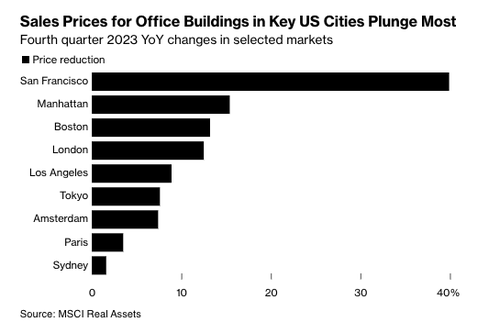The Intel: News, Trends & Investigative Reports
The best news and analysis from across the spectrum to make you the most informed person in the room.
Caffeinated intel from across the spectrum
Free. Weekly. Easy unsubscribe.

By THE INTEL Editors
Trend intelligence report: Commercial real estate’s slow-motion crash - winners and losers
The commercial real estate market is being hit from a number of angles at once. This trend intelligence brief by THE INTEL summarizes seven financial press sources published in early 2024. These analyses point to 1) escalating delinquency rates, 2) non-performing loans, 3) declining valuations, with office properties most harshly affected, and 4) a forced refinance of ~20% of CRE loans at much higher interest rates in 2024.
Reading time: 4 min
A staggering 20% of US commercial and multi-family real estate debt will mature in 2024, according to Bloomberg.
Owners and fund managers will have to refinance - at much higher rates.
Already, the National Bureau of Economic Research states that 45% of office loans are underwater and 300 regional banks face runs by the end of Q3 2024.
Trends
- Office buildings have high vacancy rates that show few signs of recovery. Even as many sectors have fully recovered from the pandemic, employees have been hesitant to physically return to offices and companies have realized some savings by having them stay home.
- This has stabilized into hybrid work, with lower demand for office space.
- AI firms are moving in. But, they have comparatively small workforces and even with massive investment may not fill the buildings with office dwellers they are displacing.
- Office buildings are expensive to upgrade or retrofit to other uses.
- Similar crises in Germany, China, and elsewhere are exacerbating global commercial real estate risk.
Cases
- Blackrock sold a NYC office building at 50% discount
- A former FedEx facility in Green, OH reportedly sold for $9/sq.ft.
- Los Angeles tower auctioned at a 45% discount
- FDIC recorded $6 billion loss on one $15 billion portfolio
Countertrends
- Morningstar interviewed experts who believe the pending crisis is exaggerated. They forecast that CRE investors will innovate and revitalize the sector. They point to 1) ample unvested capital in the system and 2) diversified distribution of the loans.
- Aaron Klein of Brookings similarly notes that the sector doesn't meet crisis-criteria due to 1) lack of clarity in asset mispricing and 2) a reversal of the remote-work trend.
- San Francisco supervisor Wiener (D) proposes removing a bundle of regulations (called CEQA) in downtown SF to facilitate transitions between building uses, such as transitioning from office to higher-demand residential or educational uses. Expect these transitions to take time. More immediately, such regulatory changes may help facilitate refinancing for some commercial real estate.
- Some buyers aim to capitalize by scooping up bargains. For instance Buffet protégé Ian Jacobs, announced plans to acquire 3 million sq.ft. of SF office space at just 30% of new construction cost. He’s raised $750 million with a projected 10yr investment horizon. Ares Management and RXR are following suit.
Analysis
Fortune reports that top economist, Gary Shilling, who predicted 2008 housing crash, now says the commercial real estate bubble is about to burst.
Kevin O'Leary, of "Shark Tank," summarized an impending collapse of the commercial real estate sector on the Kudlow Report. Like others, he highlighted the risk of vacant office buildings, particularly Boston, where up to 40% of buildings sit empty.
Refinancing these properties poses a significant challenge at higher rates and reduced demand and subsequently will threaten regional banks. O'Leary noted the market may never fully recover due to the changing nature of work post-pandemic. And, repurposing these spaces, though theoretically possible, faces obstacles such as zoning regulations and high costs in converting to storage or housing.
The slow burn of commercial real estate pressures will intensify over coming quarters. 1.5 trillion of commercial real estate loans, previously financed at historically low rates, will come due and need to be refinanced by the end of 2025. Half of these loans sit on bank balance sheets.
While the Federal Reserve faces pressure to address inflation and stabilize financial markets, the deepening crises in regional banks and commercial real estate pose significant challenges.
The reliance on liquidity and rate cuts may provide temporary relief but risks exacerbating underlying issues, including inflated valuations and potential asset bubbles.
Balancing inflation control with financial stability remains a delicate task, requiring proactive risk management strategies and evaluation of economic interdependencies. For instance, the recent trend analysis for Germany may be a bellwether for other industrialized nations.
The belief that the Federal Reserve can manage the situation solely through liquidity and rate cuts contrasts with the interconnected risks facing the economy, particularly regarding real estate, energy, and social pressures.
Resources
Trend intelligence report: German industry, energy, and the proposed green transition
CRAINS: Former FedEx unit HQ in Green expected to sell for 'pennies on the dollar'
MORGAN STANLEY: Commercial Real Estate's Uncertain Future
BLOOMBERG: The Brutal Reality of Plunging Office Values Is Here, February 13, 2024


